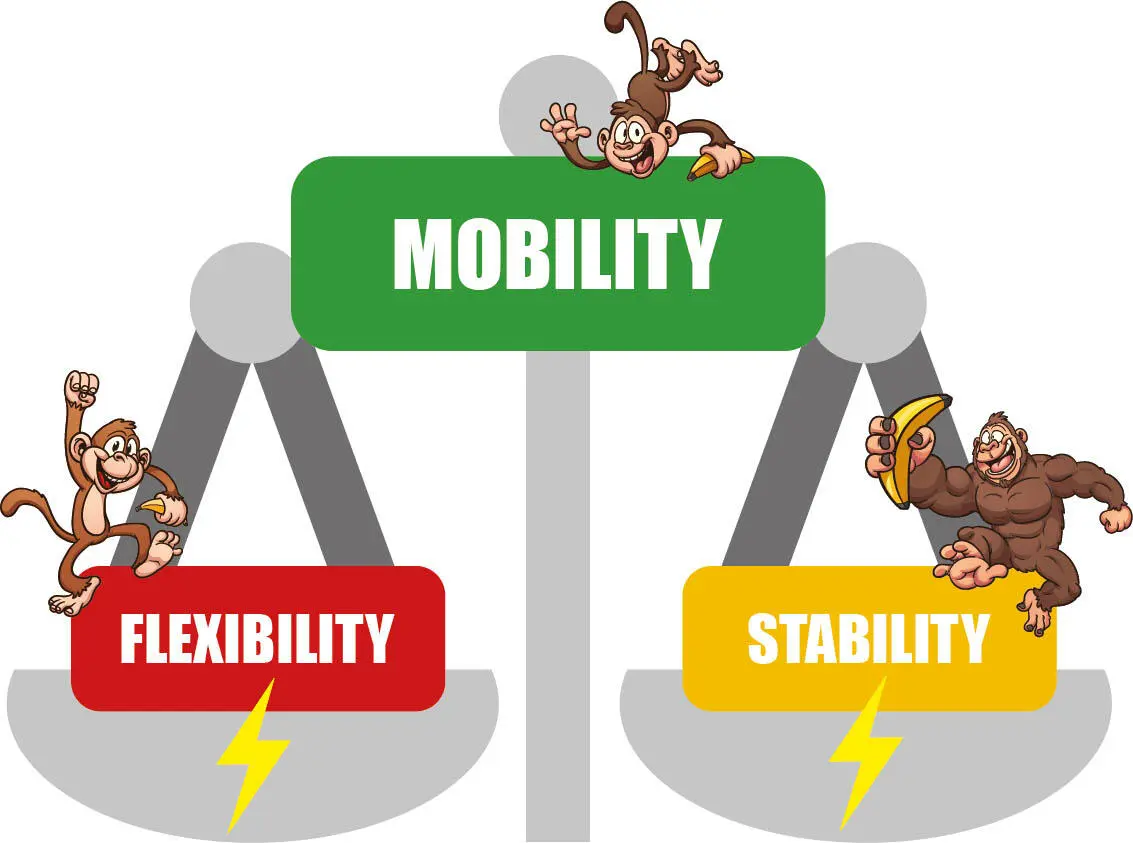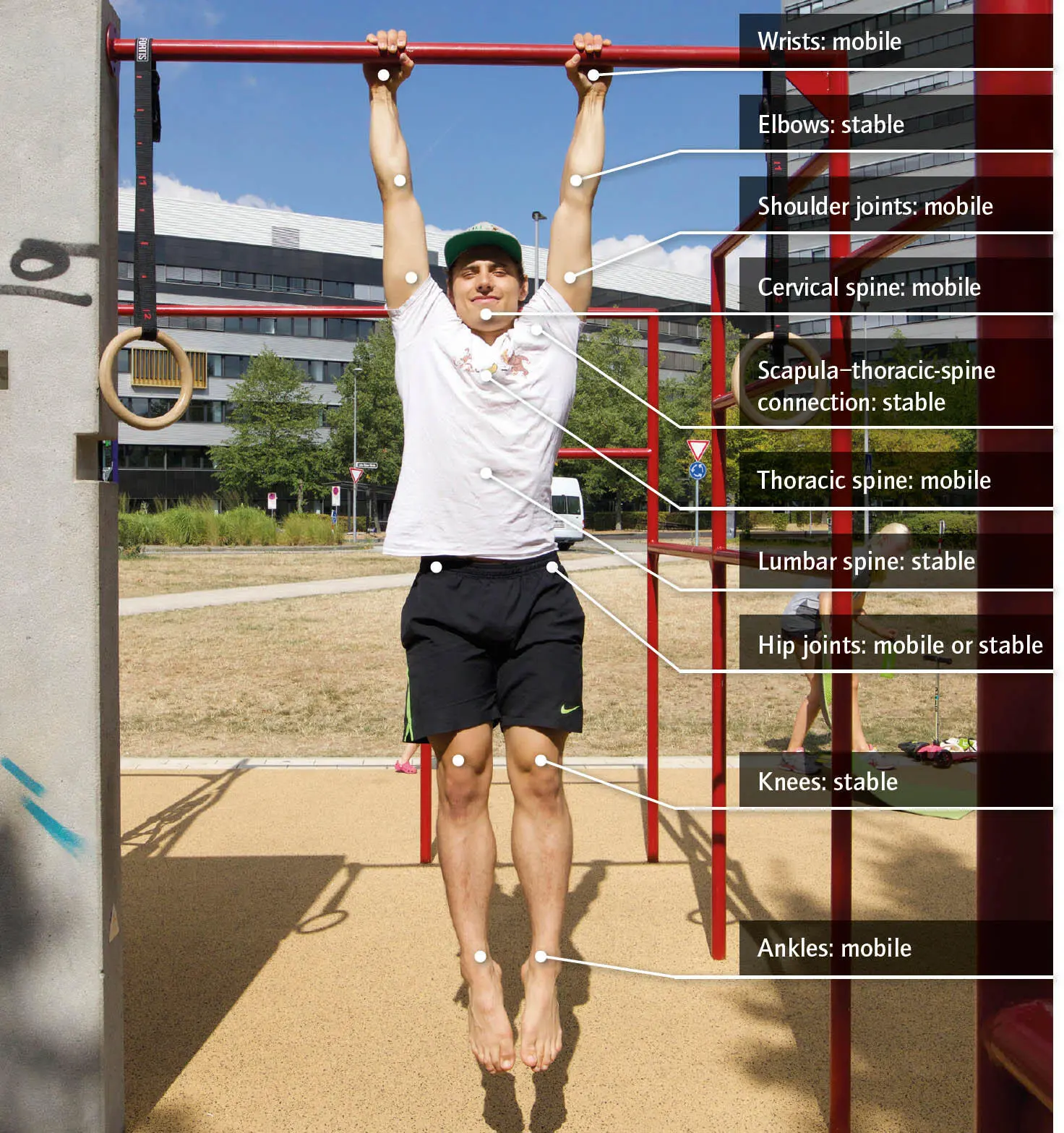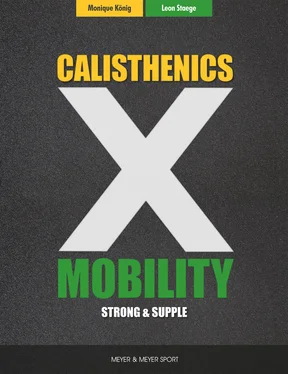Disrupting homeostasis is a trigger for lots of pains and limitations. This means possible imbalances in strength and flexibility and can even cause an issue with balance. When you learn to activate your joints and muscles, meaning having sensory and motor control, you’ll become more flexible.
Of course, it doesn’t sound particularly motivating when I tell you that you should practice improving your body’s motor control. That’s why my goal with this book is for you to learn to enjoy mobility training and then practice moving in different ways.
Your brain determines your mobility (and strength). When you learn to control your joints and muscles, you also control your movements and make your brain feel more secure. The more secure your brain feels, the more flexible you’ll be.
2.2 THE REASON WE’RE SO STIFF
Eyes, ears, mouth? I thought I had to move to become more mobile!
Absolutely correct. Ultimately, moving is always a priority. From an evolutionary standpoint, when someone doesn’t move, that person becomes easy prey!
When it comes to mobility, I don’t wish to confuse you but, rather, to provide clarity in the jungle of diverse methods and opinions in order to make you mobile and pain-free.
You can greatly change your mobility and performance by affecting your eyes, ears, and your tongue. But this falls into the area of applied neurology training.
Although the transitions are fluid, in this book I want to offer you a simpler and more familiar approach to exercise.
As I see it, an overwhelming problem today lies in the fact that we don’t move enough or that our movements are overly one-sided. Not to mention that we have the ability to use our body to perform movements that should be easy to execute for a normal locomotor system, such as the following:
• Sitting cross-legged
• Squatting
• Hanging from a bar for at least 30 seconds and even up to 60 seconds
• Bending over
• Jumping to a knee-high surface
• Running backward
• Circling each arm in two different directions while standing
These movements aren’t a valid test of your biomechanics. Apart from any scientific and evolutionary rationales, they’re movements that, in my opinion, are part of normal functionality.
Our modern daily lives require us to use our body less and less. The lack of mobility and loss of body awareness take on a disastrous toll as early as elementary school.
As an elementary-school teacher, Monique can tell you a thing or two about that reality. In elementary school, students certainly sing a lot of songs, and alongside early musical instruction, reading, writing, and math remain, of course, a very important part of our lives.
But with elementary-school PE classes already being cut and only the advancement of the “intellect” being made a priority, we’ll soon live in a society overrun by academics, with everyone suffering from joint pain.
Of course, this is a very one-sided picture, and in my opinion, we won’t experience such a grievous societal change like the one portrayed in the Disney movie WALL·E. Nevertheless, we can’t ignore exercise and health. A person can be extremely educated, but if she’s unable to move her body, she’ll neglect a large portion of her potential.
Physical work greatly supports mental work, as many studies on learning and exercise show. This aspect represents the biggest deficiency–or, rather, the greatest imbalance–in our education system, since the only physical ability we’re taught from kindergarten all the way to high-school graduation is sitting.
In a society in which the education system ignores physical development and the healthcare system prioritizes disease control over preserving and promoting health, we have no choice but to become proactive.
Our body constantly alternates between buildup and deterioration. At some point deterioration will win, but we decide the speed at which this process advances and the quality of life with which we age. Do we aspire to wheeled walkers and being in constant fear of being trapped–of falling and not being able to get up again on our own? Not being able to do even half a squat to get up from the toilet without help or not having sufficient arm and core strength to be able to break a fall and prevent a hip fracture?
Or do we aim to age with a resilient body that allows us to play with our grandchildren and be strong enough to master everyday challenges and live autonomously until the final day of our existence?
2.3 DON’T MOBILIZE EVERY JOINT
As I mention in chapter 1, “Mobility–Modern Flexibility Training,” we shouldn’t mobilize every part of the body.
When someone mobilizes everything and forgets to create tension in certain areas, that person will experience symptoms similar to someone who only strengthens the muscles but never mobilizes. Pain and injuries occur when we ask too much of our body, exercise in too one-sided of a manner, or forget about balance. I cover more on this topic in section 3.2, “Pain and Injuries.”

For example, let’s think about ball sports, like soccer and tennis. Torn ligaments are common occurrences in these sports. Usually, the problem is that the athlete never practiced the position in which she got injured. Hence her brain and nervous system didn’t have the information on how to stabilize her body or the joint in the respective position.
As I mention in section 2.1, “How to Become More Mobile,” it’s critical that we maintain control over our joints if we want to stay mobile and injury-free in the long term.
The joint-by-joint approachhelps differentiate between stable and mobile joints. This determines which priorities you should set in your mobility training.:

One question I often get on Instagram is this: “How can I make my lower back more mobile? That part of my body feels so rigid when I deadlift or during yoga.”
As the joint-by-joint approach shows, your lower back (lumbar spine) should be stabilized. To make your spine more mobile, it’d be better to focus on your thoracic spine and your hips. These two areas are crucial to your upper body’s overall mobility, which is why they must be mobilized when there are limitations. By contrast, the lower back links the upper and lower body. When there’s too little stability in that area, the other joints must work harder to maintain the body’s basic stability.
One reason why some of my coaching clients are stiff is having too little stability in their core, which is why all other joints are producing an excess of tension. I cover more on that in section 3.3, “Guideline for Pain-Free Training.”
2.4 WHY STRETCHING AND YOGA WON’T MAKE YOU MORE MOBILE
But, Leon, what about the muscles? Don’t they have to be stretched and mobilized to be more flexible?
Ultimately, your muscles are simply the executing organs of your nervous system’s signals.
It’s the job of your muscles to move your joints and protect them. Flexibility happens in the joints. OK, but my muscles are tight!
Right. So let me explain.
The purpose of all mobility exercises is to move your joints into an “unfamiliar” position and to learn to control it via muscle tension. When you learn to control your joint position, your nervous system registers this input and responds (output) by releasing your muscles, with efficient tension, at their current length.
Читать дальше














